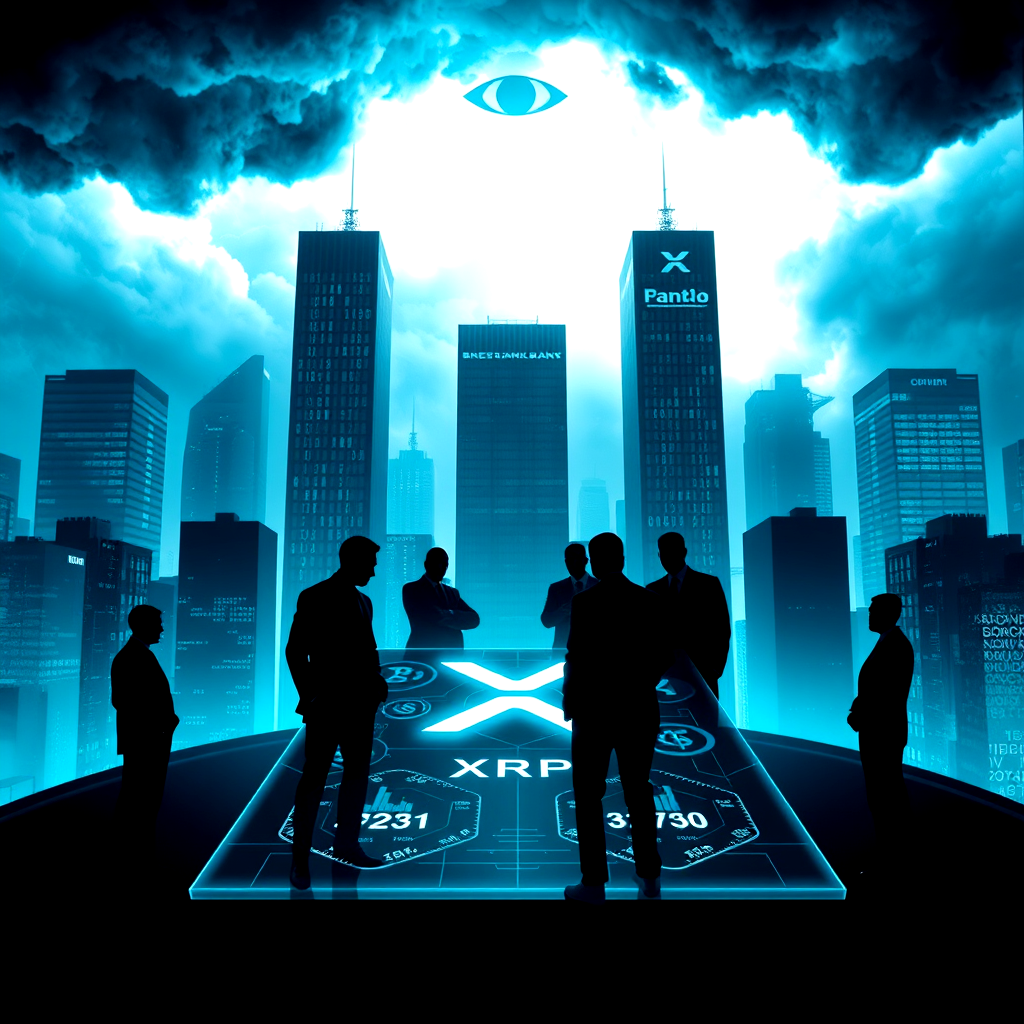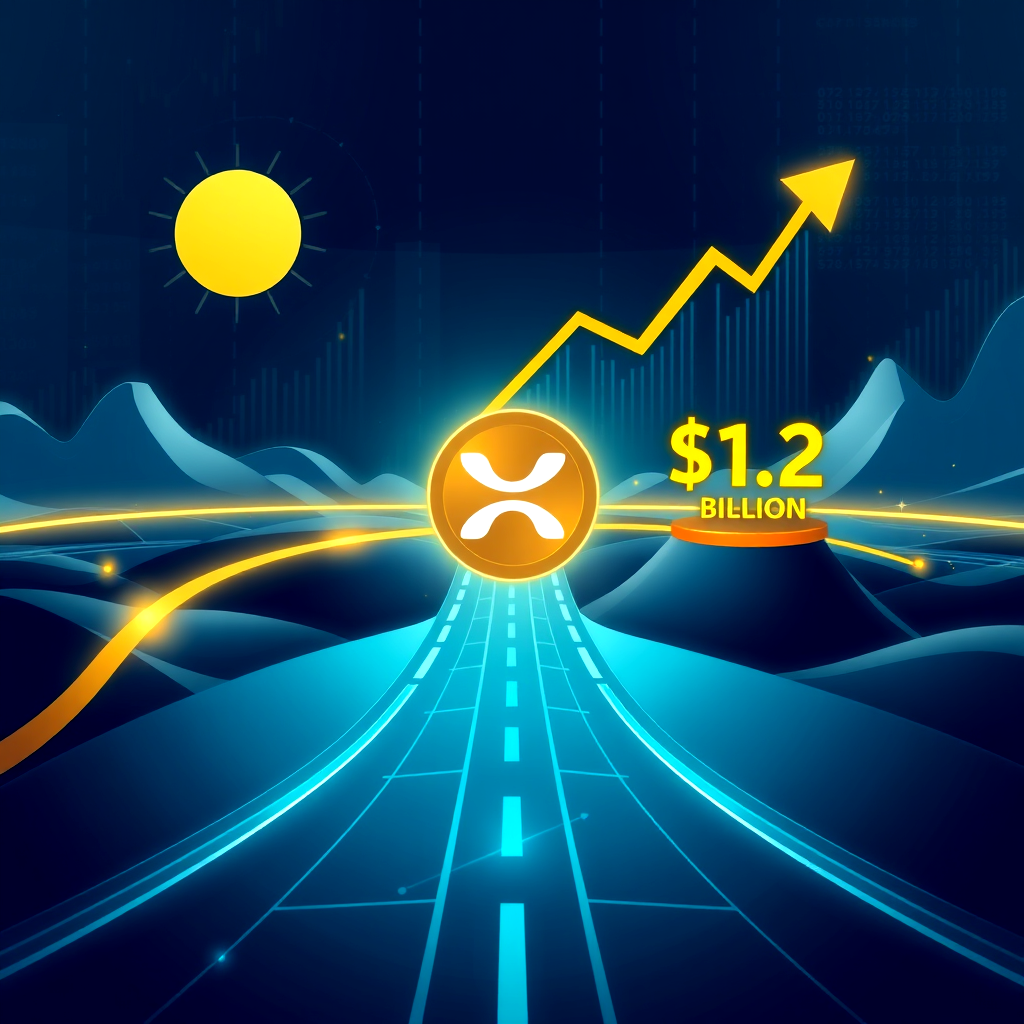
By Anonymous Insider
In the chaotic swirl of cryptocurrency, where Bitcoin’s anarchists scream freedom and retail traders chase memes, one player has quietly played a different game—a game of patience, power, and duplicity. Ripple, the San Francisco-based fintech, has spent over a decade building what it calls the “Internet of Value,” a system to wire the world’s financial repositories—banks, payment firms, exchanges—for instant, dirt-cheap transfers. Unlike Bitcoin’s rebel yell, Ripple’s mission isn’t to torch the system but to upgrade it, laying rails for a global ledger that banks, not bros, control. And at the heart of this plan sits XRP, a digital asset bled dry by design, only to rise as the banking system’s chosen one. Behind the curtain, whispers of elite players—Peter Thiel, Elon Musk, and PayPal’s old guard—holding secret XRP stashes under pseudonyms like “Isaac Newton” hint at a deeper script. Add a 1988 prophecy, a $50 million fine paid in XRP, and BlackRock’s deafening silence, and the writing’s on the wall: XRP isn’t just a coin—it’s the banks’ endgame.
The Prophecy: A 1988 Glimpse of Crypto’s Rise
Long before Bitcoin’s 2009 genesis, a 1988 article in The Economist dared to predict a digital currency revolution. Titled “One World, One Money,” it envisioned a global system by 2015, where “electronic cash” would bypass borders, powered by cryptography and untethered from central banks’ grip—or so it seemed. The article didn’t name cryptocurrencies, but its foresight—encrypted, borderless value—reads like a blueprint for Bitcoin, XRP, and beyond. By 2015, Bitcoin was six years old, a $6 billion experiment, while XRP, born in 2012, was quietly wiring banks like Santander. The prophecy wasn’t wrong, but it missed the twist: crypto wouldn’t dethrone banks—it would serve them.
Bitcoin vs. XRP: Anarchist Beta vs. Bankers’ Star
Bitcoin hit the scene in 2009, a cypherpunk’s middle finger to fiat, promising peer-to-peer money without suits. By 2012, it was a niche rebellion, trading at $13 with a $200 million market cap. That same year, Ripple emerged—not as OpenCoin’s dream to topple banks, but to enhance them. XRP, its native token, wasn’t mined by basement rigs; it was pre-created (100 billion tokens), with 50 billion locked in escrow for “adoption.” Bitcoin’s anarchist ethos—decentralized, loud—clashed with XRP’s compliance, cozying up to regulators and banks from day one.
Their trajectories tell the tale. Bitcoin soared to $103,000 by 2024, a $1.3 trillion juggernaut minting 18,000 millionaires in one run (Henley & Partners, 2024). Regulators tamed it as “digital gold” (CFTC, 2015), a store of value dwarfed by gold’s $13 trillion. Central banks hoard 36,000 tons of bullion ($2.5 trillion, 2024), yet gold’s $2,700/oz stalls—odd, when demand screams. Bitcoin’s beta test worked: it distracted rebels, hyped crypto, but never threatened banks’ $150 trillion empire.
XRP’s path was bloodier. It peaked at $3.84 in 2018, then crashed to $0.40 lows (2020-2023) under a brutal SEC lawsuit alleging unregistered securities sales. While Bitcoin partied, XRP bled—delisted by Coinbase, shunned by retail. Yet banks like HSBC, SBI, and Standard Chartered stayed loyal, using Ripple’s tech (XRP Ledger, or XRPL) for $10 billion daily peaks. XRP’s compliance—60+ global licenses, FinCEN’s 2015 currency nod—made it banks’ quiet bet. By April 2025, XRP’s $2.00 price and 280% Q4 2024 surge signaled resurrection. Bitcoin was the gentile’s fire; XRP was Jesus, crucified for banks’ glory.
The SEC Lawsuit: Charade and Stress Test
The SEC’s 2020 lawsuit wasn’t a fight—it was a script. You don’t sue a coin FinCEN called currency, demand $2 billion, then settle for $50 million in XRP unless you’re playing both sides. Ripple’s settlement, finalized in March 2025, is a masterstroke of duplicity: $50 million total (~25.5 million XRP at $2.00) split between the SEC and U.S. government, likely $25 million each, pending Q3 2025 approval. Ripple keeps $75 million of the original $125 million fine (escrowed since August 2024) plus $2-3 million in interest. CEO Brad Garlinghouse crowed on Fox Business (April 12, 2025), “We’re paying in XRP—shows what this ledger can do.” Chief Legal Officer Stuart Alderoty echoed on X, calling it a “regulatory green light.”
This wasn’t punishment—it was theater and a trial run. The charade scared retail—nobody buys a coin fighting Uncle Sam. XRP’s $0.40 lows (2020-2023) and $15 billion market cap hit (Garlinghouse, 2025) kept traders away while banks like SBI stacked escrow’s 40 billion XRP (2017-2025). The SEC’s retreat—$2 billion to $50 million, no appeal (March 2025)—under Trump’s crypto-friendly admin smells staged. Paying in XRP crowns it currency, not security, like a bank-orchestrated nod.
The stress test proved XRPL’s bank chops. Settling $50 million (25.5 million XRP) in 4 seconds at 1,500 TPS with $0.0002 fees screams readiness for Hidden Road’s $3 trillion annual flows (2025). Ripple’s $75 million keep is the banks’ wink—pass the test, pocket the change. The lawsuit’s duplicity bled XRP to let banks buy low, then raised it for their ledger. Narrative trumps action when you know the endgame, and banks wrote this script.
Hidden Road: The $3 Trillion Checkmate
Ripple’s $1.25 billion acquisition of Hidden Road (April 2025) isn’t just a flex—it’s a coronation. Hidden Road, a prime brokerage, settles $3 trillion yearly for 300+ clients—hedge funds, banks, traders. Regulators greenlit this deal faster than a SWIFT wire, despite Ripple’s SEC scars. Why? Because banks, with $150 trillion in assets (2024), don’t answer to retail—they run the show. Hidden Road will use XRP for payments and RLUSD, Ripple’s dollar-pegged stablecoin, as collateral, wiring TradFi to crypto without breaking a sweat.
XRPL already handles $10 billion daily peaks. If 1% of Hidden Road’s $3 trillion shifts to XRP, that’s $30 billion daily, spiking token demand. RLUSD, backed by treasuries, stabilizes trades—banks love it, unlike Tether’s murk. This isn’t Ripple fighting Wall Street; it’s building their pipes. HSBC’s Metaco deal (2023), Standard Custody’s licenses (2024), and 70+ bank partners (Santander, BBVA) show banks adopted XRP, not Bitcoin’s 7 TPS chaos. The lawsuit’s $0.40 lows were the altar; Hidden Road’s $3 trillion is the throne.
The Silent Elites: Thiel, Musk, and “Isaac Newton”
Behind XRP’s rise, whispers of elite players linger. Peter Thiel, PayPal co-founder and bank insider (Palantir’s $10 billion valuation, 2025), allegedly holds XRP under the pseudonym “Isaac Newton.” No wallet screams “Thiel,” but the clue fits his style—nerdy, like his Tolkien-inspired Valar Ventures. Founders Fund backed Ripple’s precursor, OpenCoin, in 2013, and PayPal tested XRP payments (2018). Early XRP wallets (2012-2014) used handles like “xrp_king”; “Isaac Newton” could mask millions—say, 10 million XRP bought at $0.40 ($4 million then, $20 million now). Thiel’s silence—no XRP tweets—mirrors banks’ stealth. The $50 million fine’s XRP payment greenlights it; why talk when banks hide, too?
Elon Musk’s no stranger to the game. In a 2023 X clip (@XRP_Army), he choked on an XRP question—“uh, no comment”—like a kid caught stealing cookies. Musk’s X Money, with 41 state licenses (2025), might eye XRP for crypto payments (no X token, per his 2023 denial). If he bought 1 million XRP at $0.006 (2013), that’s $2 million at $2.00. PayPal’s OGs—Thiel, Hoffman, Levchin—swam in crypto early; XRP’s bank ties would’ve pulled them in. They called it “Ripple,” never “XRP,” dodging hype while banks stacked escrow’s 40 billion. The fine’s XRP flex—25.5 million to SEC/government—breaks their silence, but they’re still mum. Banks want XRP’s “Jesus” moment theirs.
BlackRock’s Silence: The Loudest Clue
Enter Larry Fink, BlackRock’s $11.5 trillion titan. In January 2024, when Fox Business’s Charles Gasparino asked about an XRP ETF after BlackRock’s Bitcoin filing, Fink dodged: “I can’t talk about that—you don’t want me to talk about it.” Why hide? BlackRock’s iShares Bitcoin Trust (IBIT) launched that month, raking $40 billion by April 2025 (Bloomberg). Its Ethereum ETF (July 2024) hit $1 billion—weak sauce next to IBIT. But XRP? Nada. Eighteen XRP ETF filings—Bitwise, 21Shares, Canary Capital—pile up (CryptoSlate, March 2025), with 82% approval odds by 2026 (Polymarket). Not one’s BlackRock’s.
This screams banks hoarding XRP. BlackRock, cozy with banks (Citi, JPMorgan clients), pushes Bitcoin ($1.3 trillion cap) and Ethereum ($500 billion) to distract retail—gentile bait. XRP’s $2.00 and $126 billion cap (2025) are for banks’ $3 trillion flows (Hidden Road), not ETFs. Fink’s “don’t talk” mirrors Thiel’s “Isaac Newton” and Musk’s choke—banks’ orders. The $50 million fine—25.5 million XRP to SEC/government—proves XRP’s clean, but BlackRock’s absence says banks want it private, wired to XRPL and RLUSD for $33 trillion U.S. debt plays.
The Debt Play: Stablecoins and the Future
Speaking of debt, XRP and RLUSD aren’t just for trades—they’re for empires. U.S. debt sits at $33 trillion (2024), with $1 trillion yearly interest by 2030. Banks, holding $6 trillion in treasuries, could liquidate it via stablecoins like RLUSD—pegged 1:1 to USD, backed by bonds. Hidden Road’s $3 trillion could scale RLUSD to trillions, settling debt on XRPL’s 4-second rails. Trump’s “Crypto Reserve” buzz (X, March 2025) might scoop the fine’s 25.5 million XRP, aligning government with banks’ $150 trillion muscle. Ripple’s custody buys—Metaco, Standard Custody—hint at tokenizing gold, stocks, even debt itself. XRP’s not for crypto bros; it’s banks’ ledger for the next era.
The Endgame: Narrative Over Action
Ripple’s game was never rebellion—it was wiring banks to win. The 1988 prophecy saw crypto’s spark, but missed banks’ grip. Bitcoin’s anarchist beta test lit up retail; XRP’s compliance built rails. The SEC lawsuit’s duplicity—charade to scare, stress test to strengthen—bled XRP to $0.40 for bank buys, then raised it to $2.00 for Hidden Road’s $3 trillion. The $50 million fine in XRP and $75 million keep scream banks’ script. Thiel’s “Isaac Newton,” Musk’s silence, and Fink’s dodge hide the truth: XRP’s Jesus, risen for banks, not gentiles. No documents needed—$150 trillion moves via Metaco, escrow’s 40 billion, and XRPL’s speed. The narrative’s won, and XRP’s lights are on.










2 Responses
the more i think about it. i agree.
the more i think about it. i agree.